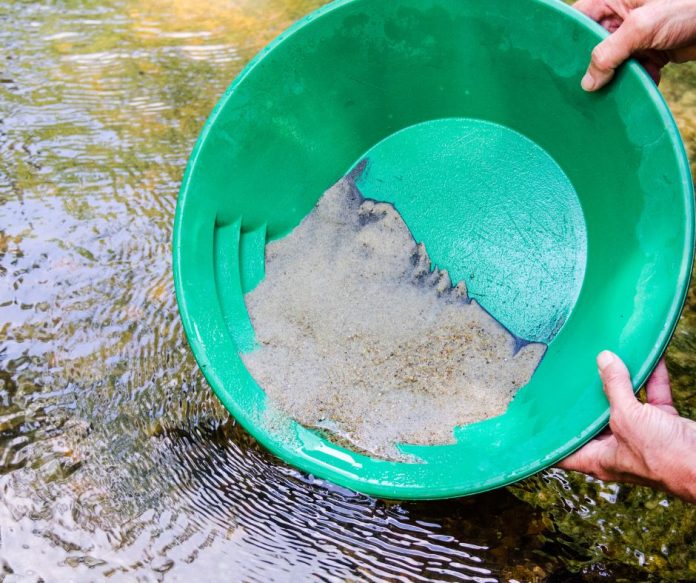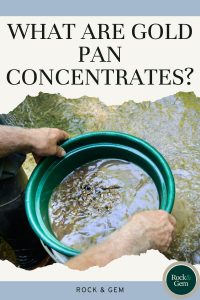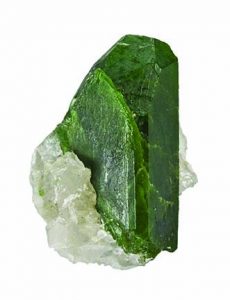
Gold panners tend to categorize their pan concentrates as either gold or “black sand”—and discard the latter without much of a second look. And that’s too bad because pan concentrates often consist of a diverse array of minerals which, viewed under a 10X loupe, display colors and forms that are keys to their identification. At the least, pan concentrates are telltale indicators of upstream geology.
Gold panning, the simplest form of hydraulic gravitational separation, relies on differences in mineral density, which is measured in specific gravity. The specific gravity of quartz, the primary component of most sands and many rocks, is 2.65. That of native gold is most often between 17.0 and 18.0. Because of gold’s far greater density, it remains in the pan while the common, quartz-based gravels are washed away.
Most Common Concentrates

Most gold-pan concentrates consist of relatively dense, iron-based minerals such as magnetite (iron oxide, ferrous-ferric), hematite (iron oxide, ferric), ilmenite (iron titanium oxide), and chromite (iron chromium oxide), all of which have substantial specific gravities. between 4.3 and 5.3. Their generally dark colors are the origin of the term “black sand.”
With careful panning techniques, minerals with specific gravities as low as 2.9 will remain in the pan concentrate.
These minerals can include everything from the sulfides, oxides, and carbonates of heavier metals to such relatively dense gemstones as diamond, ruby and sapphire (corundum), topaz, garnet, spinel, and chrysoberyl.
Concentrates Aid In Deposit Discovery
Both the historic silver discoveries at Nevada’s Comstock Lode and Leadville, Colorado, were made by gold miners who identified oxidized silver minerals in their pan concentrates. Gold panners also discovered Montana’s five major sapphire deposits.
Sometimes pan concentrates can be a big problem. I once sluiced gold-bearing gravels in an Alaskan creek—where the pan concentrates consisted largely of tiny bits of native lead—from which the gold particles could be separated only by amalgamation.
Even in this age of high-tech mineral exploration, panning remains a valuable prospecting tool for many minerals other than gold. In the late 1980s in northern Canada, pan concentrates led to the discovery of diamond-bearing kimberlite pipes.
Prospecting for ‘Indicator Minerals’ Pays Off

(Photo courtesy The Arkenstone, IRocks.com)
When exploration geologist and prospector Chuck Fipke panned his way across 400 miles of tundra, he was not searching for diamonds per se, but for the “diamond-indicator” minerals that typically associate with diamonds in kimberlite environments, but are much more abundant and readily identifiable.
Fipke was specifically looking for black ilmenite (iron titanium oxide), red pyrope garnet (magnesium aluminum silicate), and green chromium-rich diopside (calcium magnesium silicate), which all have sufficient densities to be retained in pan concentrates.
During several years of prospecting, Fipke never panned a single diamond. He did, however, follow a trail of ilmenite, pyrope, and diopside. He eventually panned a green diopside crystal with no alluvial wear at all—enough to convince him that he was standing atop the eluvial remains of weathered kimberlite pipe. Core drilling revealed a kimberlite pipe that has since been developed into the billion-dollar Ekati diamond mine.
Along with the common black sands, you’ll find an array of other minerals with densities mostly in the 3.0-5.0 specific-gravity range.
Under a loupe, the combination of colors can be eye-catching. The common garnet-group minerals impart bright orange, pink, and red hues. Some concentrates even have a “Christmas tree” appearance when garnets mix with another common, dense mineral—green epidote (basic calcium aluminum iron silicate).
Panning Leads to Fascinating Discoveries
Although many minerals in gold-pan concentrates are abraded and rounded from alluvial wear, some retain enough of their original crystal forms to aid in identification.
So gold pans are not just gold-recovery tools, but geological sampling instruments. Take a closer look at those ubiquitous “black-sand” concentrates and you’ll be pleasantly surprised at the cornucopia of interesting minerals that meet the eye.
This story about gold pan concentrate appeared in Rock & Gem magazine. Click here to subscribe. Story by Steve Voynick.















